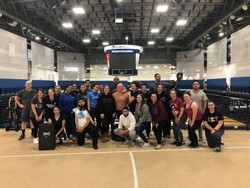What would you do if your life was on the line? Would you know how to defend yourself? Most people think that they do not have to worry about questions like these. They think that it can’t possibly happen to them.
But in reality, it can happen to anyone. No matter what age or gender you are, it can happen when you least expect it.
For example, mistaking the wrong car as your Uber. This recently happened to Samantha Joesphson, a New Jersey resident who attended the University of South Carolina. She got into a car that she thought was her Uber without checking to see if it was the correct car. If she had taken the time to check the plates of the car or ask the driver who they were picking up before getting into the car, she might have avoided this tragedy.
The world can be a scary place. You never know what could happen, all you can do is to make yourself more aware and prepare yourself. One way you could prepare yourself is by taking a self-defense course. Some of you might be thinking that it’s not for you or that it’s only for women. Self-defense courses are for every one of all genders and all ages.
“I wish self-defense courses weren’t necessary. Sadly, they are. Everyone – male and female – can benefit, regardless of age or skill level,” said Chris Hirschler, Ph.D. an associate professor and the Chair of the Health and Physical Education Department.
Hirschler teaches the self-defense course here at Monmouth. This class is a one-credit PE course that is held for half a semester. This class is open to all Monmouth students in the fall and spring semesters.
“It very much exceeded my expectations. I learned so much more than I thought I was going to learn” said Zach Cosenza, a senior communication student.
Cosenza is currently taking the course with Hirschler. When asked if self-defense courses are just for females, he said, “I do not think self-defense classes are just for females. Most males don’t know how to enter a self-defense situation just as much as females.”
Students enrolled in the self-defense course watch situational videos, give a presentation on a type of martial art, learn self-defense techniques, and read articles to increase awareness of potential attacks.
According to Cosenza, some techniques being taught are how to punch and kick properly, takedowns for after being grabbed, and how to increase your speed by performing sprints.
“Things happen so fast and the ability to ensure your own safety without relying on someone to save you is important,” said Nick Verzicco, a senior business administration-finance student. “Those seven weeks of training could be the difference between life and death.”
“Self-defense courses build confidence and allow you the ability to defend yourself if attacked,” said William McElrath, Chef of the Monmouth University Police Department. “I think self-defense courses are a good idea for everyone.”
Many students should learn basic self-defense techniques, but not every student can fit the course in their schedules. This was the case for Jennifer Alkess, a senior health studies student, and her sisters who are a part of the Chi Upsilon Sigma National Latin Sorority. To fix this, Alkess reached out to Hirschler to organize and create a self-defense class for her and her sorority. She thought that they would only have 20-25 participants, but there were about 65 participants that participated in the event.
When asked why she wanted to create this event she explained, “The self-defense course is great. However, for students that cannot make that commitment, or cannot fit it in their schedule, they were missing out on a great opportunity to learn how to defend themselves. This event gave them that.”
If you are not able to take a self-defense class, there are some tips to use if you are ever in a bad situation. According to an article published in Journal of Physical Education, Recreation & Dance, the two most important elements of assault prevention are avoidance and deterrence.
While deterrence is a victim’s attempt to keep the assaulter from using violence so an assault does not occur, avoidance is an awareness of one’s physical surroundings to prevent a potential attack. The first tip is to always be aware and to not look like an easy target. This could be just looking around while walking or before leaving your car.
A good way to be aware while walking is keeping your head up and not starring down at your phone. When you are on your phone, you take your attention away from the area around you. Also, when you are walking, try not to have your headphones in, especially at night.
Attackers love the element of surprise and when you have your headphones in, you won’t be able to hear them coming. These situations can make you appear more vulnerable and an easier target.
The second tip is to know that every second counts. Most people don’t know how to react when they are being attacked. Usually they freeze and have a late reaction. Trust your gut; if something doesn’t feel right to you, it most likely isn’t.
If your life is on the line, you have to do anything you can to get away. And no matter what goes down, fight to avoid being taken to a second location. If the attacker takes you to a second location, the chances of escaping decreases.
The third tip is to make sure you can get to your car safely. If you know that you are going to park your car somewhere and when you return it is going to be nighttime, make sure you park your car near a street light or lamp post. When you do this, it makes it harder for attackers to hide by your car and wait.
Also, when walking back to your car, try to avoid clicking the car starter or using the lock button to locate your car. It will let the attacker know where you are heading and where to wait for you. When you walk to your car, make sure you have your keys in your hand. This can be helpful to unlock your car faster. If you keep one of your keys in between your fingers, this will help you be prepared if anyone tries to attack.
The last tip is to make sure you get into the correct Uber or Lyft. Using these driving services is helpful especially when you are not able to drive. However, when using these services, you have to be extra careful and make sure that you don’t go into the wrong car. To make sure that doesn’t happen, check to see if the car, license plate, and picture of the driver matches what it shows on the app.
If you can’t tell or can’t see the plate, go to either the passenger seat window or to the door of the backseat behind the passenger seat. Ask the driver who they are picking up, but make sure when you ask, you don’t mention your own name. If they don’t know or say a different name, do not enter that car and wait for your correct car to show up.
These are just some tips that you can keep in mind while you are going about your everyday life. Just remember that this can happen to anyone and that you can change the outcome of it. Now, when it comes down to it, are you prepared to fight for your life?




